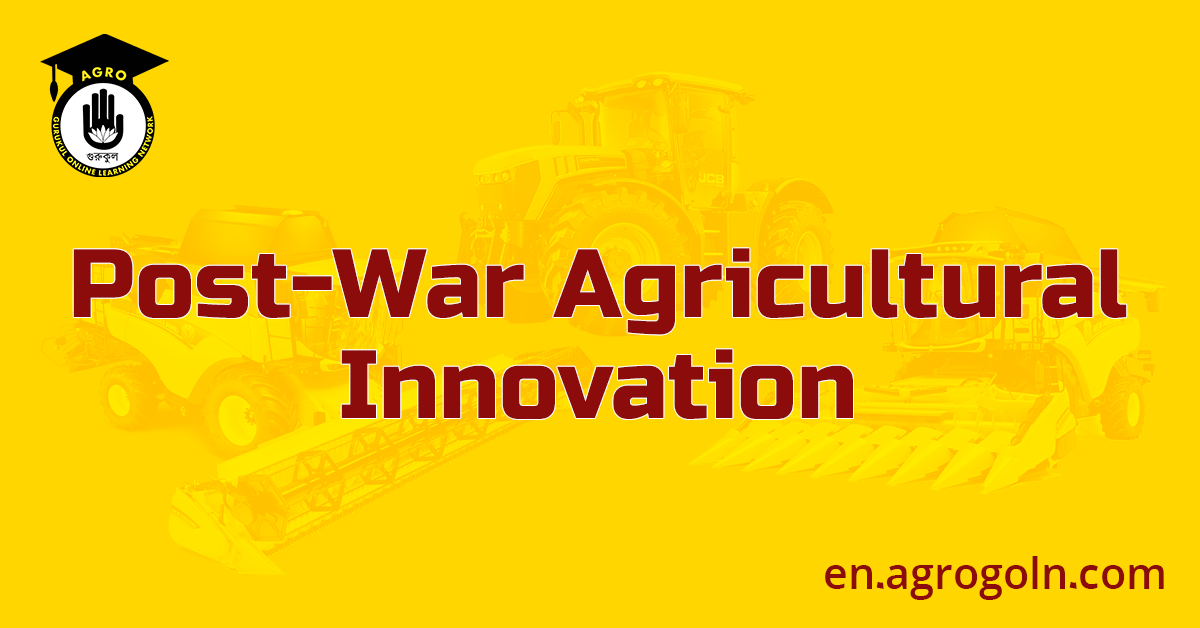The period after World War II marked a significant turning point in agricultural history, as nations around the world faced the challenges of rebuilding their economies and feeding their populations. This era witnessed a remarkable surge in agricultural innovation, driven by technological advancements, scientific discoveries, and a growing understanding of agricultural systems. The post-war agricultural revolution transformed the way food was produced, leading to unprecedented increases in agricultural productivity and laying the foundation for modern agriculture as we know it today. This article explores the key innovations and developments that shaped post-war agriculture and their lasting impact on global food production.
Table of Contents
Post-War Agricultural Innovation

1. The Green Revolution: A Quantum Leap in Crop Yields
One of the most significant developments in post-war agricultural innovation was the Green Revolution. This movement, initiated in the 1940s and 1950s, sought to increase agricultural productivity by introducing high-yielding crop varieties, improved irrigation techniques, and synthetic fertilizers and pesticides. Scientists, led by Norman Borlaug, developed semi-dwarf wheat and rice varieties that responded better to fertilizers, resulting in substantially increased yields.
The Green Revolution, particularly in countries like India, Mexico, and the Philippines, led to dramatic improvements in crop yields and helped avert widespread famine. However, it also sparked debates about the environmental and social impacts of industrialized agriculture, including concerns about biodiversity loss, water pollution, and the concentration of land ownership.

2. Mechanization and Agricultural Machinery
The post-war era witnessed a significant increase in the use of agricultural machinery and mechanization. Tractors, combine harvesters, and other farm equipment replaced traditional manual labor, leading to increased efficiency and productivity. Mechanization reduced the labor requirements in agriculture, allowing many people to move to urban areas, contributing to the growth of industrial sectors in economies worldwide.
The advent of precision agriculture technologies, such as GPS-guided tractors and drones, further revolutionized farming by enabling more precise and efficient application of inputs like fertilizers and pesticides. These advancements continue to reshape modern agriculture, improving resource management and environmental sustainability.
3. Agrochemicals and Crop Protection
The post-war period also saw a surge in the development and widespread use of agrochemicals, including synthetic fertilizers, herbicides, and insecticides. These chemical inputs played a crucial role in enhancing crop yields and controlling pests, but they also raised concerns about environmental pollution and the development of resistance in pests and weeds.
Over time, concerns about the negative impacts of certain agrochemicals led to the development of integrated pest management (IPM) strategies, emphasizing a more sustainable and ecologically sound approach to crop protection. IPM combines the use of chemical inputs with biological controls and cultural practices to minimize the impact on the environment and preserve beneficial insects.
4. Advancements in Plant Breeding and Biotechnology
Plant breeding and biotechnology have played a pivotal role in post-war agricultural innovation. Traditional breeding techniques, combined with advances in genetics and genomics, have led to the development of crop varieties with improved traits, such as disease resistance, drought tolerance, and higher nutritional content.
The development of genetically modified organisms (GMOs) has been a subject of both excitement and controversy. GMOs offer the potential to address various agricultural challenges, such as pest resistance and food security. However, concerns about the safety, environmental impact, and potential monopolization of seeds by large corporations have fueled debates about their widespread adoption.
5. Irrigation and Water Management
Efficient water management became a critical focus in post-war agriculture, particularly in regions facing water scarcity. Innovations in irrigation technologies, such as drip irrigation and sprinkler systems, revolutionized water delivery to crops, increasing water use efficiency and crop productivity.
Water-saving techniques like rainwater harvesting and water recycling have also gained traction, enabling sustainable water use in agriculture. As climate change exacerbates water scarcity in many regions, efficient water management remains crucial for ensuring food security and environmental sustainability.
6. Agricultural Knowledge and Information Sharing
The post-war era saw a significant expansion in agricultural research and knowledge sharing. Governments, international organizations, and universities invested in agricultural research, leading to new insights and innovations. Organizations like the Consultative Group on International Agricultural Research (CGIAR) and the Food and Agriculture Organization (FAO) played crucial roles in coordinating and disseminating agricultural knowledge globally.
Advancements in communication technologies, such as the internet and mobile phones, have further facilitated the sharing of agricultural information and best practices. Farmers now have access to weather forecasts, market prices, and expert advice at their fingertips, empowering them to make informed decisions and optimize their practices.

The post-war period brought about a wave of agricultural innovation that transformed food production and global food security. From the Green Revolution’s leap in crop yields to the mechanization of agriculture and the advent of biotechnology, these innovations have shaped modern agriculture and enabled us to feed a growing global population.
However, these advancements have also brought challenges, including concerns about environmental sustainability, biodiversity loss, and social equity in agriculture. As we face the complexities of the 21st century, the lessons from the post-war agricultural revolution serve as a reminder of the need for continuous innovation and sustainable practices to ensure food security and environmental stewardship for future generations
. Embracing new technologies, while also considering their social, environmental, and economic implications, will be crucial in addressing the multifaceted challenges of agriculture in the years ahead. By combining innovation, scientific research, and responsible practices, we can build a more resilient and sustainable agricultural system that can meet the needs of a rapidly changing world.
